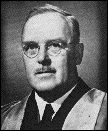 |
 |
 |
|
|
|
|
The traditional view of the scientific method suggests that the experimenter formulates a hypothesis, fashions an experiment to test the idea, analyzes data from the experiment, and then using these data draws a conclusion regarding the validity of the hypothesis.
 |
 |
 |
|
|
|
|
What is now called Rutherford Scattering was initially intended as a busy-work exercise for Ernest Marsden, then an undergraduate physicist working in Rutherford's lab under the direction of Hans Geiger. Within days, Marsden produced evidence of the existence of a small but very massive structure buried deep inside the atom. Said Rutherford of the discovery "It was almost as if you fired a fifteen-inch shell at a piece of tissue paper and it bounced back and hit you ." A useful account leading up to this event can be found at http://www.phys.virginia.edu/classes/252/Rutherford_Scattering/Rutherford_Scattering.html
The discovery of the nucleus raised as
many questions as it answered.
A . What scheme determines the outer reaches of the atomic perimeter?
......1 If electrons are stationary, what keeps them separated
from the nucleus?
.....2) If the electrons orbit the nucleus, the physics of Maxwell
suggests that the electrons should spiral into the nucleus, radiating
energy all the while. No such energy was observed.
B. Then there is the matter of describing the forces in the nucleus that must be superseding the Coulomb repulsive forces among positive protons in close proximity to each other in the nucleus.
| Mod-06 |
http://dbhs.wvusd.k12.ca.us/AtomicStructure/Rutherford-Exp-History.html http://dbhs.wvusd.k12.ca.us/AtomicStructure/Rutherford-Model.html |
|
|
Keeping Up With the Curies The Gold Foil Scattering Experiment How Do Scattering Experiments Work? Rutherford's Atom Bibliography |
The questions regarding the deployment
of electrons around the nucleus will be answered plausibly if
not definitively by Neils Bohr in 1913. And suprisingly, the first
attempt at an atomic model is relatively understandable. Click
here to see the derivation.
http://www.rwc.uc.edu/koehler/biophys/7a.html
a good summary of this topic may be found at
http://web.jjay.cuny.edu/~acarpi/NSC/3-atoms.htm
Last edited 12/26/05